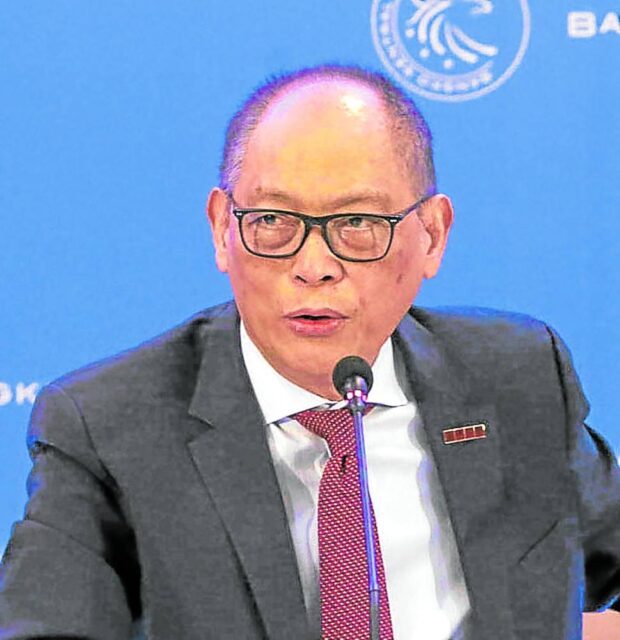Landbank releases P50 B as share in Maharlika Investment Fund

Finance Secretary Benjamin Diokno —INQUIRER PHOTO
The Land Bank of the Philippines (Landbank) on Friday said that it had remitted its full contribution of P50 billion to the seed capital of the Maharlika Investment Fund (MIF) even as the government was still headhunting for the top brass of the company that would manage it.
Finance Secretary Benjamin Diokno, who serves as Landbank chair, said in a statement that the amount was remitted to the Bureau of the Treasury two days after the implementing rules and regulations (IRR) of the MIF law took effect on Sept. 12.
Landbank is one of three state entities that Republic Act No. 11954, which established the MIF, mandated to contribute to the fund’s initial capital of P125 billion of its authorized capital stock of P500 billion.
The state-run bank’s board approved on July 21 its capital infusion in the fund.
The MIF law also mandated the Development Bank of the Philippines (DBP) to contribute P25 billion and the national government itself to chip in P50 billion, which will mainly come from dividends declared by the Bangko Sentral ng Pilipinas (BSP).
Article continues after this advertisementAccording to Diokno, who is also the government’s representative in the Monetary Board which governs the BSP, the central bank declared last July a dividend of P31.86 billion in favor of the national government.
Article continues after this advertisementThe dividend amount was based on 50 percent of the BSP’s net income, after income tax, in 2022 of P63.73 billion.
There was no word on when the DBP and the BSP would make their contributions.
George Barcelon, president of the Philippine Chamber of Commerce and Industry, the country’s largest business group, said in an interview that the board of the Maharlika Investment Corp. (MIC) should have been established before any contributions were made.
On Aug. 29, when the issuance of the MIF law’s IRR was announced, Diokno said that the success of the fund hinged on the selection of the best people to oversee and manage it and the strict compliance with the provisions of the law.
“We want the setup of the (MIC’s) governing body shared with the public first,” Barcelon told the Inquirer. “Knowing who they are should precede any other concern.”
This should be the priority because the MIF involves funds that are “taken out of circulation” instead of being used in lending for productive activities in the case of Landbank and DBP, and for public services in the case of the national government, Barcelon said.
Lynette Ortiz, president and CEO of Landbank, said in a statement that the MIF law had enough safeguards to protect the P50 billion that state bank invested in the fund.
‘Adequate safety nets’
“The MIF law has put in place adequate safety nets to ensure full disclosure and transparency in the management of the fund, as well as the integrity and professionalism of the management team that will be entrusted to lead the (MIC),” Ortiz said.
In his statement on Friday, Diokno said there was “a growing interest for investments in the MIF from multilateral financial institutions and foreign investors.”
He reiterated that with the regulatory requirements in place and after securing the seed capital from state-run institutions, “we are confident that the fund will be operational by year-end.”
The government is now actively recruiting for the top managers of the MIC, setting a Sept. 27 deadline for nominations.
The search is for the MIC’s president and concurrent chief executive plus two regular and three independent directors from the private sector.
Investment strategies
Completing the nine seats of the MIC board are the finance secretary as chair and the respective president and CEO of Landbank and DBP. MIC is intended to identify financially and commercially viable infrastructure projects to invest in, and will formulate investment strategies covering emerging “megatrends,” such as environment, social and governance, digitalization; and health care.
It would also invest in a wide range of assets, including foreign currencies, fixed-income instruments, domestic and foreign corporate bonds, joint ventures, mergers and acquisitions, real estate and high-impact infrastructure projects, and projects that contribute to the attainment of sustainable development.
Red flags
While the establishment of the MIF was still pending in Congress, critics of Maharlika said it was being pitched as a sovereign wealth fund, which other countries had created with surplus revenues and focused more on accumulating wealth rather than stabilizing national finances.
They also cited red flags in the MIC’s governance structure, which they said was poorly designed and could open the floodgates for political interference, mismanagement and corruption.
The Marcos administration’s economic team argued that the the final version of the law as well as the IRR address these concerns, especially the governance issues.